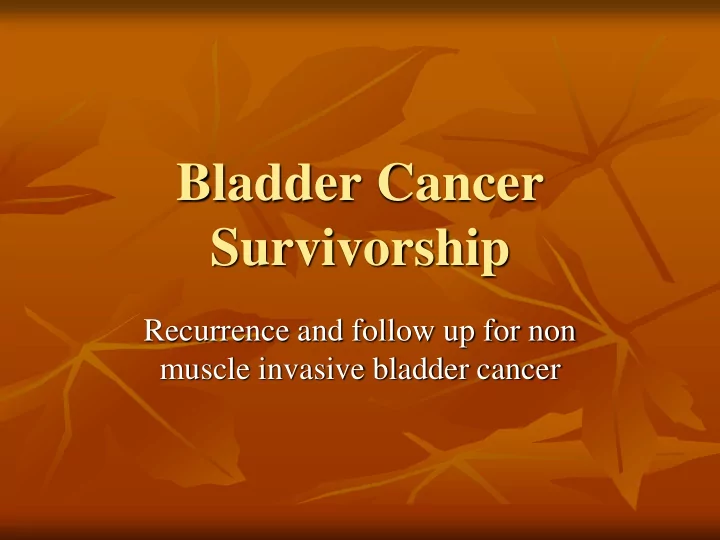

Bladder Cancer Survivorship Recurrence and follow up for non muscle invasive bladder cancer
Bladder Cancer Facts More than 70,000 new cases each year 4 th most common cancer in men 9 th most common cancer in women In USA today there are more than 500,000 bladder cancer survivors. Risks: Cigarette smoking and exposure to chemicals.
Recurrence Facts for Non-Muscle Invasive Bladder Cancer Bladder cancer is a very treatable disease but has a very high recurrence rate. The recurrence rate can be up to 80% The recurrence rate is related to the grade, size and number of tumors and history of the disease High grade, multiple or large tumors are more likely to recur.
Recurrence Facts Continued Recurrence is more common in the first 12-24 months after diagnoses but can appear many years later Strongest prognostic factor for recurrence is the result of the FIRST cystoscopy done about 3 months after the TURBT.
Treatments to Decrease the Recurrence Rates Chemotherapy are often given immediately after the first tumor resection and can decrease recurrence rates by 20% BCG (immunotherapy) and chemotherapy are often given once a week for 6 weeks. For maintenance or “booster” therapy BCG is given weekly for a period of 3 weeks. Schedules for these treatments vary greatly between physicians
Consequences of High Recurrence Rates. Extremely important to adhere to life-long surveillance A traditional schedule for surveillance can be: Cystoscopy every 3 months for 2 years Cystoscopy every 6 months for 2 years Cystoscopy every 1 year for life Schedules can vary among physicians, however all agree on cystoscopy at 3 months after TURBT and lifelong surveillance.
Emotional Consequences from High Recurrence Rates Fear of recurrence Grieving due to loss of health Guilt: “ If only I never smoked” Anger: “ I never smoked and have lived healthy, it is not fair” Fear of painful procedures for a lifetime
What can the Bladder Cancer Survivor do to Live a Happy and Healthy Life After Diagnosis If possible find a provider that you trust and have faith in Educate yourself: Find out the grade, the size and multiplicity of the tumors. Utilize resources such as BCAN Join a local support group Talk to your provider, nurse or social worker
Support & Education Seek support from family and friends Quit smoking to reduce risk of recurrence of bladder cancer and reduce the risk of developing other cancers and diseases related to smoking Eat healthy: some studies have shown that fruit and vegetables will decrease the risk of recurrence Continue to engage in work, hobbies and fun activities
Summary Remember that the follow up surveillance and maintenance therapies are crucial for your survivorship.
Recommend
More recommend